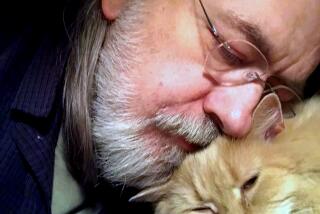Dick King-Smith dies at 88; his book about a talking pig became the film ‘Babe’
Dick King-Smith, an internationally popular British children’s author whose best-known book, the amusing and inspiring story of a sheep-herding pig who talks, was turned into the hit 1995 movie “Babe,” has died. He was 88.
King-Smith died in his sleep Tuesday morning at his home near Bath, England, after experiencing poor health in recent years, his publisher, Random House Children’s Books, said in a statement.
A failed farmer who became a teacher, King-Smith was in his late 50s when his first children’s book, “The Fox Busters” — the tale of henhouse chickens who scheme to drive away invading foxes — was published in 1978.
Since then, he had written more than 100 books — many of them what he called “farmyard fantasies” — that have reportedly sold more than 15 million copies worldwide.
But his most famous book was his sixth, “The Sheep-Pig,” published in England in 1983 and retitled “Babe: The Gallant Pig” when it was published in the United States in 1985. The book won the Guardian Children’s Fiction Prize in 1984, with one judge declaring it “perfect.”
It’s the story of a piglet who is won at a fair by a sheep farmer and adopted by the farm’s mother sheepdog, Fly.
Trained to herd sheep by Fly, the polite Babe puts his own spin on getting sheep to obey.
“If I might ask a great favor of you, could you all please be kind enough to walk down to that gate where the farmer is standing, and to go through it? Take your time, please, there’s absolutely no rush.”
The author, who tapped his years of working with farm animals for his writing, had an affinity for pigs — despite a fondness for eating bacon.
“It’s something I may have to see my psychiatrist about but, yes, I have a real soft spot for pigs,” he told the Daily Telegraph of Sydney, Australia, in 1996. “I like pigs as friends and for their intelligence. I have always admired them.”
King-Smith, who sold the movie rights to “The Sheep-Pig” to Australian writer-producer George Miller shortly after it was published, was a fan of the Chris Noonan-directed movie.
“Obviously, I was nervous and a bit worried in case the adaptation messed up the original story in any way,” he said in the Daily Telegraph interview. “But I knew within minutes of taking my seat in the cinema I would not be disappointed. They did a truly marvelous job. I was delighted.”
The film was nominated for seven Academy Awards, including best picture, and won an Oscar for best visual effects.
Described in the Guardian of London in 1996 as “a genial character — a witty, urbane countryman of entertainingly contradictory enthusiasm,” King-Smith did his writing in the small study of his 17th century cottage a few miles from where he was born.
Writing in longhand in the morning and then typing it up with one finger on an old portable typewriter in the afternoon, he created animal characters that were known for displaying human characteristics while retaining their animal traits.
“I allow them some human ones, especially speech, because it is such fun putting words into their mouths,” he once said.
In his review of King-Smith’s book “Pigs Might Fly,” published in “Children’s Literature in Education,” Arthur Arnold observed: “King-Smith’s writing stands comfortably alongside the more celebrated E.B. White’s, sustained by his own inimitable wry sense of humor.”
King-Smith’s 2001 autobiography is titled “Chewing the Cud: An Extraordinary Life Remembered by the Author of Babe, the Gallant Pig,” and was described by one British reviewer as being “as much a memoir of the animals he has known and loved as of the people closest to him.”
The son of a paper mill director, he was born March 27, 1922, in Bitton, Gloucestershire, England, where his early life revolved around pet rabbits, tortoises, rats and mice.
He attended Marlborough College and worked on a farm for a year before serving in the British Army’s elite Grenadier Guards during World War II. King-Smith, who was severely wounded in Italy, married his first wife, Myrle, in 1943. They had three children, Juliet, Elizabeth and Giles.
After the war, King-Smith and his wife, who died in 2000, worked a small farm — a 20-year enterprise he termed “a disaster.”
“I was a good stockman but a very poor accountant,” King-Smith told London’s Evening Standard in 1995.
He then sold asbestos suits for firefighters and spent three years working in a shoe factory before earning a bachelor’s degree in education at Bristol University and beginning a new career as an elementary school teacher at age 53.
After the publication of his first book, King-Smith continued to teach and write for several years. He retired from teaching to write full time at age 60 in 1982.
In addition to his three children, he is survived by his second wife, Zona; 14 grandchildren; four great-grandchildren; and a great-great-grandchild.
More to Read
Start your day right
Sign up for Essential California for the L.A. Times biggest news, features and recommendations in your inbox six days a week.
You may occasionally receive promotional content from the Los Angeles Times.






